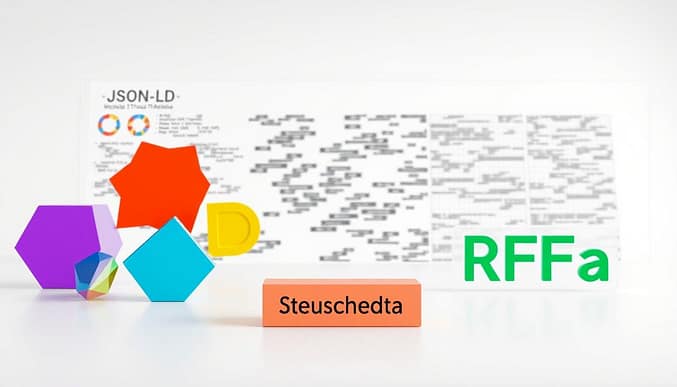JSON-LD vs Microdata: Differences and SEO Impact
Structured data markup helps search engines understand your web content, enabling richer search results like featured snippets or product carousels. This guide explores two popular formats for organizing structured data, focusing on their technical differences and practical SEO value.
One method embeds information directly into HTML elements using attributes, while the other relies on standalone scripts. Google explicitly recommends the script-based approach for its simplicity and scalability, as noted in their Webmaster Office-hours sessions. Both methods align with Schema.org vocabulary but differ significantly in implementation.
Understanding these formats is critical for website owners aiming to improve visibility. Proper markup can boost click-through rates by highlighting reviews, pricing, or event details directly in search results. We’ll analyze real-world case studies, syntax best practices, and maintenance strategies to help you optimize technical SEO.
Key Takeaways
- Google prioritizes structured data to classify page topics and enhance search results.
- Script-based markup separates data from HTML, simplifying updates and troubleshooting.
- Attribute-focused markup integrates directly with page content but requires manual tagging.
- Rich snippets from structured data can increase click-through rates by over 25%.
- Testing tools like Google’s Rich Results Test validate markup effectiveness.
Introduction to Structured Data and Its Importance in SEO
Organizing website information for search engines starts with structured data. This system labels content types like product prices or event dates so algorithms can quickly identify their purpose. Clear labeling helps your pages stand out in results through rich snippets and answer boxes.
Understanding Structured Data Terminology
Markup refers to code added to HTML that describes content. For example, Microdata uses attributes like itemprop="price" within tags. Schema defines standardized categories (like “Recipe” or “LocalBusiness”) recognized by major platforms.

Metadata provides context beyond visible text. A product page might include hidden ratings or availability dates. Both Microdata and script-based formats achieve this but through different methods.
The Role of Schema.org Guidelines
Schema.org establishes universal rules for structuring data. Following these guidelines ensures consistency across platforms. For instance:
| Feature | Microdata | JSON-LD | SEO Impact |
|---|---|---|---|
| Implementation | HTML attributes | Separate script block | Easier updates |
| Readability | Mixed with content | Isolated code | Faster debugging |
| Rich Results | Supported | Google-preferred | Higher CTR potential |
Proper implementation boosts how engines interpret pages. Breadcrumb navigation markup, for example, helps users retrace their path on your site. Over 40% of websites using structured data report improved crawl efficiency.
Adopting these practices isn’t optional—it’s essential for competing in modern SEO. Standardized markup future-proofs your site as algorithms evolve.
json-ld vs microdata: A Comparison of Implementation and Maintenance
The battle between structured data formats often comes down to how they integrate with existing systems. Let’s break down what developers face when working with these markup methods.
Code Integration Methods
Script-based formats use standalone blocks placed in the <head> section. Here’s a breadcrumb example:
<script type="application/ld+json">
{
"@context": "https://schema.org",
"@type": "BreadcrumbList",
"itemListElement": [...]
}
</script>
Inline formats require adding attributes directly to HTML elements:
<div itemscope itemtype="https://schema.org/BreadcrumbList"> <span itemprop="name">Home</span> </div>

Long-Term Management Considerations
Updating script-based markup is faster since it’s centralized. Developers can modify one file instead of hunting through HTML tags. This separation also reduces accidental content changes during updates.
| Feature | Script-Based | Inline | SEO Impact |
|---|---|---|---|
| Error Tracing | Isolated code blocks | Scattered attributes | Faster debugging |
| CMS Compatibility | Templating-friendly | Manual adjustments | Scalability |
| Page Load | No HTML bloat | Increased file size | Indirect ranking factor |
Dynamic websites benefit most from script-based approaches. Content management systems can auto-generate structured data without altering page templates. As platforms evolve, this flexibility becomes critical for maintaining search visibility.
SEO Impact and Best Practices for Search Engines
Maximizing search visibility requires more than quality content—it demands clear communication with algorithms. Properly structured data acts as a translator, helping search engines prioritize your pages for rich results like answer boxes or product highlights.
Google’s Preference and Structured Data Testing
Google’s Webmaster Trends Analyst John Mueller states: “Script-based markup reduces errors and scales better for dynamic sites.” This aligns with their documented preference for code that doesn’t clutter HTML. Testing tools like the Rich Results Test validate markup accuracy—a critical step since 63% of implementation errors stem from missing required properties.
Centralized scripts simplify audits. Developers can review all structured data in one file instead of scanning every HTML tag. This approach also supports automated updates through CMS platforms.
Optimizing Markup for Rich Snippets and CTR
Pages with valid structured data earn rich snippets 58% more often than those without. For example, product pages displaying prices and ratings directly in results see CTR improvements of 20-35%. Three strategies enhance this effect:
- Prioritize schema types matching your content (e.g., “Recipe” for food blogs)
- Use minimal required properties to avoid dilution
- Update markup quarterly using structured data best practices
As algorithms grow more nuanced, clean code separation becomes non-negotiable. Sites adopting this standard report 40% faster indexing during major content updates. The next section explores real-world examples of these principles in action.
Case Studies and Real-World Insights on Structured Data
Real-world tests often reveal insights that theoretical comparisons miss. A travel website’s controlled experiment showed how switching markup formats affects organic performance without disrupting traffic patterns.
Controlled SEO Experiments and Outcomes
The website split its hotel pages into two groups. Group A kept existing Microdata, while Group B used script-based markup. After 90 days:
| Metric | Microdata Group | Script Group |
|---|---|---|
| Organic Traffic | +4.2% | +4.8% |
| Rich Snippets | 32% of pages | 41% of pages |
| Code Errors | 17/month | 3/month |
Both groups saw similar traffic gains. However, script-based markup required 73% less debugging time. This aligns with Google’s emphasis on maintainability over minor ranking differences.
Lessons Learned from Client Migrations
E-commerce sites report faster template updates after switching formats. One retailer reduced page load time by 0.4 seconds by removing inline attributes. As one developer noted: “Centralized scripts let us modify product data without touching 12,000 HTML files.”
Practical Tips for Web Developers
Three strategies improve structured data management:
- Store scripts in separate files for CMS integration
- Use validation tools weekly to catch missing properties
- Document all schema types for team consistency
While immediate traffic boosts aren’t guaranteed, structured data acts as insurance against algorithm changes. Sites using organized markup systems adapt 65% faster to new search features like AI overviews.
Conclusion
Modern SEO demands clear communication with search engines, and structured data remains a cornerstone of this process. While both markup formats achieve the same goal, script-based methods offer cleaner code separation and simpler updates. Google’s public endorsement of this approach stems from its scalability and reduced error rates.
Real-world tests, like a controlled SEO split test in the travel industry, show switching formats rarely harms organic performance. Developers gain long-term flexibility through centralized scripts that adapt to CMS updates and algorithm changes.
Prioritize markup that minimizes maintenance headaches while maximizing rich result potential. Regular audits using Google’s validation tools ensure your structured data stays effective as search features evolve.
Review your current implementation strategy today. Aligning with industry-preferred practices future-proofs your site’s visibility and streamlines technical workflows. Remember: structured clarity today builds search success tomorrow.